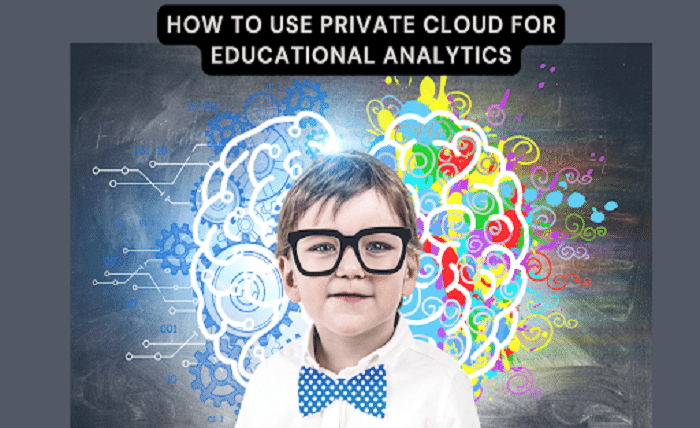How to Use Private Cloud for Educational Analytics

In today’s digital age, educational institutions are increasingly turning to data-driven approaches to improve decision-making and operational efficiency. With 90% of organizations viewing data as a critical asset, we cannot overstate the importance of analytics solutions in education.
This exploration into the private cloud for educational analytics will reveal how this technology revolutionizes data management and utilization in schools and universities.
The Role of Private Cloud in Educational Analytics
- Enhanced Security and Confidentiality
Security is a primary concern for educational institutions managing data. Public cloud solutions, while convenient, often fall short in this area. Private cloud solutions address this issue head-on by providing:
- Dedicated infrastructure
- Customizable security protocols
- Greater control over data access and storage
- Greater Control Over Data Management
When it comes to handling sensitive educational data, control is key. Private clouds offer educational institutions the ability to:
- Design their data management practices to specific needs
- Ensure compliance with educational data regulations
- Maintain full oversight of data storage and access
It’s no wonder that organizations prefer private solutions for sensitive data handling due to compliance requirements.
Setting Up a Private Cloud for Educational Institutions
Setting up a private cloud for educational analytics is a critical process that requires careful planning and execution. When it comes to implementation, educational institutions generally have two main options:
- On-premise solutions: This involves setting up and maintaining the private cloud infrastructure entirely within the institution’s data centers. It offers maximum control but requires significant upfront investment and ongoing maintenance.
- Hybrid solutions: This approach combines on-premise infrastructure with cloud services from a third-party provider. It offers a balance of control and flexibility, which is why 82% of educational leaders believe hybrid solutions are critical for optimizing resource allocation.
When choosing between these options, consider factors such as your institution’s IT capabilities, budget constraints, and specific security requirements. The decision-making process is similar to choosing between a cloud vs premise based contact center, where organizations must weigh the benefits of control against flexibility and scalability.
Selecting the Right Private Cloud Platform
With the cloud computing market in education projected to grow from $8.13 billion to $25.36 billion by 2026, there’s a wide array of platforms to choose from. Consider the following factors:
- Choose a platform that can grow with your institution’s needs.
- The platform should be user-friendly for your IT staff and end-users.
- Ensure the platform can integrate seamlessly with your existing systems and educational software.
- Although the initial investment may be high, consider the long-term operational costs and potential savings.
Popular private cloud platforms for education include OpenStack, VMware vCloud, and Microsoft Azure Stack.
Integration of Analytics Tools with Private Cloud
Once your private cloud infrastructure is in place, the next crucial step is integrating analytics tools to use your data effectively.
Popular Educational Analytics Tools
Several powerful analytics tools can be integrated with your private cloud environment:
- Tableau: Offers data visualization capabilities, making it easier to interpret complex educational data.
- Power BI: Provides business intelligence features, allowing for in-depth analysis of student performance and institutional operations.
- SAS Analytics: Offers advanced statistical analysis and predictive modeling, useful for identifying trends and forecasting outcomes.
These tools can be seamlessly integrated into your private cloud environment, enabling real-time data analysis and reporting capabilities.
Integration Process
The integration process typically involves the following steps:
- Data preparation: Ensure that your educational data is clean, properly formatted, and accessible within your private cloud environment.
- Tool configuration: Set up your chosen analytics tools to connect securely to your private cloud data sources.
- User access setup: Configure user roles and permissions to ensure appropriate access to data and analytics tools.
- Testing and validation: Thoroughly test the integrated system to ensure data accuracy and system performance.
Impact of Integrated Analytics
The integration of analytics tools with private cloud infrastructure can have a significant impact on educational outcomes. Data-driven decision-making is linked to improved student performance in educational institutions. This integration allows for:
- Real-time monitoring of student progress
- Early identification of at-risk students
- Data-driven curriculum development
- Improved resource allocation based on data insights
Data Management and Security in Private Cloud
Effective data management and security measures are paramount when using a private cloud for educational analytics.
Best Practices for Data Management
To ensure data integrity and accessibility in your private cloud:
- Implement data governance policies: Establish clear guidelines for data collection, storage, and usage.
- Regularly audit and clean your data: Maintain data quality through regular checks and data cleansing processes.
- Use data visualization tools: Use tools like Tableau or Power BI to make data more accessible and understandable to stakeholders.
- Establish clear data access protocols: Define who can access what data and under what circumstances.
- Implement data lifecycle management: Define policies for data retention, archiving, and deletion.
It’s worth noting that 80% of organizations acknowledge that limited visibility in cloud operations can lead to security vulnerabilities. Therefore, maintaining clear oversight of your data management practices is crucial.
Strategies for Securing Sensitive Educational Data
Educational institutions recognize the need for strict data protection measures, security should be a top priority. Consider implementing these strategies for secured data:
- End-to-end encryption: Ensure data is encrypted both in transit and at rest.
- Multi-factor authentication: Require multiple forms of verification before granting access to sensitive data.
- Regular security audits: Conduct periodic assessments of your security measures to identify and address any vulnerabilities.
- Staff training: Educate all staff members on data security protocols and best practices.
- Incident response plan: Develop and regularly test a plan for responding to potential data breaches or security incidents.
- Access controls: Implement role-based access control (RBAC) to ensure users only have access to the data they need.
By implementing these data management and security strategies, educational institutions can harness the power of private cloud analytics while maintaining the integrity and confidentiality of their sensitive data.
Future of Educational Analytics and Private Cloud Use
The future of educational analytics on the private cloud looks bright. With the cloud computing market in education expected to grow at a CAGR of 25.6%, we can anticipate:
- Increased adoption of AI and machine learning in educational analytics
- More personalized learning experiences driven by data insights
- Greater integration between cloud analytics and educational technologies
Conclusion
Private cloud solutions offer educational institutions a powerful tool for leveraging data to improve outcomes and operational efficiency. By providing enhanced security, control, and flexibility, private clouds are uniquely positioned to meet the analytics needs of schools and universities.
As you consider implementing a private cloud solution for your educational analytics, remember to carefully assess your specific needs and resources. With the right approach, private cloud analytics can transform how your institution uses data to drive success.
Frequently Asked Questions
What are the cost implications of setting up a private cloud for educational analytics?
While initial investments can be high, many institutions report net positive returns over time due to long-term savings on infrastructure and enhanced security.
How does the private cloud ensure the security of educational data?
Private clouds utilize advanced security features such as encryption, dedicated firewalls, and customizable access controls. Many educational institutions find these necessary for protecting sensitive information.
What are the advantages of private cloud over public cloud?
Private clouds offer enhanced security, greater control over data, and better compliance management, addressing significant concerns about data protection that are less manageable in public clouds.




